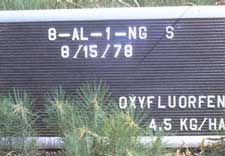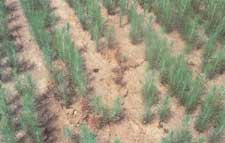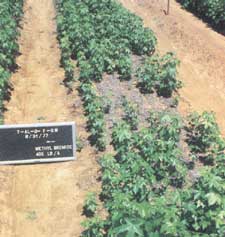Pesticide InjuryJohn W. Taylor, Jr. - Integrated Pest Management Specialist, Region 8, USDA Forest Service, Atlanta, GA, and Cordell C.E., Anderson R.L., Hoffard W.H., Landis T.D., Smith R.S. Jr., Toko H.V., 1989. Forest Nursery Pests. USDA Forest Service, Agriculture Handbook No. 680, 184 pp. Hosts Pesticide injury can occur on seedlings of all species. Damage Injury can range from slight seedling stunting to mortality. Diagnosis By maintaining untreated check plots, the nursery manager can determine if seedling injury is due to pesticides. Without check plots, diagnosis can be very difficult, even for a specialist. Successful diagnosis without check plots requires a thorough knowledge of the modes of action of the pesticides employed as well as the characteristic symptoms of injury for each pesticide. Types of Pesticide Injury The injury varies with the chemical used; the concentration contacting the seedling; the species, age, and physiological condition of the seedling; the soil texture: and other environmental considerations. Pesticide damage is most likely to occur when seedling tissue is young and succulent. Foliage - Newly formed needles may be burned as a result of oxyfluorfen application (fig. 58-1). Nitrogen fertilization treatments can increase the succulence of newly emerged tissue, thus increasing susceptibility of the plant to herbicide injury. In the South, glyphosate contact on foliage can kill young pine seedlings (fig. 58-2). Northern conifers are apparently more tolerant of glyphosate. Root System - The root system of seedlings can also be severely damaged by certain pesticides. Trifluralin can cause severe injury to root systems when it is incorporated into the soil, but root injury may be less severe if the material is applied only to the soil surface. Certain other pesticides can affect the root system when applied to the soil surface. Napropamide, for example, may cause root injury if applied to the surface of soils low in organic matter.
Misapplication - The application of a pesticide formulation that is toxic to plants is normally the result of failure to read the pesticide label carefully, failure to clean equipment properly, improper mixing of formulation, improper calibration of equipment, or improper timing of application. Drift - Pesticide drift is the movement of airborne droplets of a toxicant away from the intended point of application. The degree of drift is influenced by droplet size, microclimate, chemical formulation, and adjuvants. Selection of nozzle type and size is critical. In general, the smaller the spray droplets, the greater the drift. Hence, when applying highly phytotoxic pesticides like glyphosate, a coarse spray (large droplets) should be chosen. When phenoxy herbicides are applied on areas adjacent to seedlings, esters with low volatility are preferred. Significant drift can resuIt from use of highly volatile esters. Thickeners, additives, foaming agents, and emulsifying agents can be added to the herbicide mixture to affect droplet size and lessen drift. Weather profoundly influences drift. An inversion layer can suspend and move pesticide droplets considerable distances before they settle on sensitive seedlings. Incorrect Chemical Formulation - Careful choice of pesticide formulations can minimize the chances for plant damage when the toxicant is applied directly to seedlings. Granules and wettable powders are less likely to cause damage than are emulsifiable concentrates. Formulations and adjuvants containing oil can also injure foliage of certain species.
Prevention of Injury When properly used, pesticides can protect the nursery crop against pests that would otherwise destroy it. However, pesticides must be used according to label instructions, with proper methods and equipment, and under optimum environmental conditions to control pests and to minimize damage to seedling crops. Selected References Abrahamson, L.P. 1980. Glyphosate. a Selective herbicide in conifer seedbeds. In: Abstracts-1980 meeting of the Weed Science Society of America; 1980 February 5-7; Toronto, ON. Champaign. IL: Weed Science Society of America: 52-53. Boyer, James N. South, David B. 1984. Forest nursery practices in the South. Southern Journal of Applied Forestry. 8(2): 67-75. Marx, D.H.; Cordell. C. 1986. The effects of triadimefon on growth and ectomycorrhizal development of loblolly and slash pines in nurseries. Phylopathology. 76(8): 824-831. Marx, D.H.; Morris, W.B.; Mexal, J.G. 1978. Growth and ectomycorrhizal development of loblolly pine seedlings in fumigated and nonfumigated nursery soil infested with different fungal symbionts. Forest Science. 24: 193-202. Riffle, Jerry W. 1980. Growth and endomycorrhizal developnient of broadleaf seedlings in fumigated nursery soil. Forest Science. 26(3): 403-413. Rowan, S.J. 1978. Treflan injury of loblolly pine seedlings. Tree Planters' Notes. 29(3): 25-26. South, D.B; Gjerstad. .H.; Campbell. S.J. 1980. Comparison of methyl bromide and herbicide effects on endomycorrhizae formation, seedling production, and weed control in sweetgum seedheds. European Journal of Forest Pathology. 19(6): 371 -377. South, David B. 1980. Nurserymen must leave herbicide check plots. In: Proceedings, 1980 southern nursery conference: [date of conference unknown]: Lake Barkeley, KY. Atlanta. GA: U.S. Department of Agriculture, Forest Service: 123. South, David B.; Kelley. Walter D. 1982. Effects of selected pesticides on short-root development of greenhouse-grown Pinus taeda seedlings. Canadian Journal of Forest Research. 12: 29-35. South, David B.; Mexal, John G. 1983. Effect of bifenox and oxyfluorfen on emergence and mortality of loblolly seedlings under growth chamber conditions. In: Jones, Earl P., Jr., ed. Proceedings. 2d biennial southern silvicultural research conference: 1982 November 4-5: Atlanta, GA. Gen. Tech. Rep. SE-24. Asheville, NC: U.S. Department of Agriculture, Forest Service. Southeastern Forest Experiment Station: 418-426. |
Forest Pests: Insects, Diseases & Other Damage Agents |

|
|





